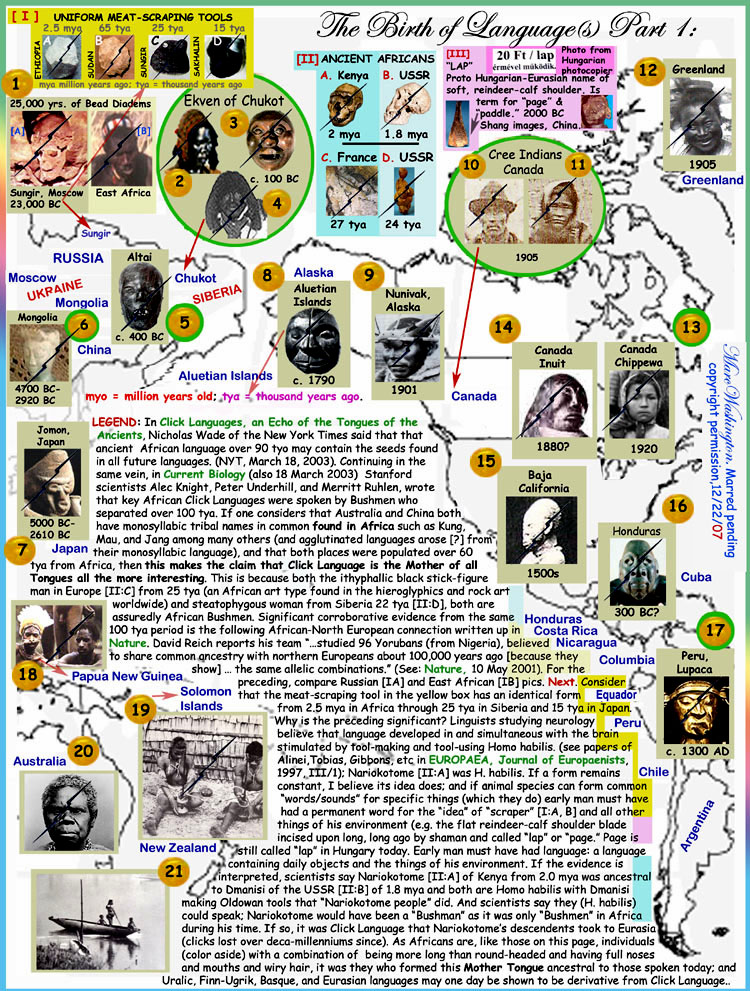
http://www.beforebc.de/all_america/900_ ... 00-21.html
The above text appears below as its presentation on the page might be too small a font-size for comfortable reading. The size below is larger and maybe easier for some to read.
LEGEND: In Click Languages, an Echo of the Tongues of the Ancients, Nicholas Wade of the New York Times said that that ancient African language over 90 tyo may contain the seeds found in all future languages. (NYT, March 18, 2003). Continuing in the same vein, in Current Biology (also 18 March 2003) Stanford scientists Alec Knight, Peter Underhill, and Merritt Ruhlen, wrote that key African Click Languages were spoken by Bushmen who separated over 100 tya.
If one considers that Australia and China both have monosyllabic tribal names in common found in Africa such as Kung, Mau, and Jang among many others (and agglutinated languages arose [?] from their monosyllabic language), and that both places were populated over 60 tya from Africa, then this makes the claim that Click Language is the Mother of all Tongues all the more interesting. This is because both the ithyphallic black stick-figure man in Europe [II:C] from 25 tya (an African art type found in the hieroglyphics and rock art worldwide) and steatophygous woman from Siberia 22 tya [II:D], both are assuredly African Bushmen.
Significant corroborative evidence from the same 100 tya period is the following African-North European connection written up in Nature. David Reich reports his team …studied 96 Yorubans (from Nigeria), believed to share common ancestry with northern Europeans about 100,000 years ago [because they show] … the same allelic combinations.” (See: Nature, 10 May 2001). For the preceding, compare Russian [IA] and East African [IB] pics. Next. Consider that the meat-scraping tool in the yellow box has an identical form from 2.5 mya in Africa through 25 tya in Siberia and 15 tya in Japan.
Why is the preceding significant? Linguists studying neurology believe that language developed in and simultaneous with the brain stimulated by tool-making and tool-using Homo habilis. (see papers of Alinei,Tobias, Gibbons, etc in EUROPAEA, Journal of Europaenists, 1997, III/1); Nariokotome [II:A] was H. habilis. If a form remains constant, I believe its idea does; and if animal species can form common “words /sounds” for specific things (which they do) early man must have had a permanent word for the “idea” of “scraper” [I:A, B] and all other things of his environment (e.g. the flat reindeer-calf shoulder blade incised upon long, long ago by shaman and called “lap” or “page.”
Page is still called “lap” in Hungary today. Early man must have had language: a language containing daily objects and the things of his environment. If the evidence is interpreted, scientists say Nariokotome [II:A] of Kenya from 2.0 mya was ancestral to Dmanisi of the USSR [II:B] of 1.8 mya and both are Homo habilis with Dmanisi making Oldowan tools that “Nariokotome people” did.
And scientists say they (H. habilis) could speak; Nariokotome would have been a “Bushman” as it was only “Bushmen” in Africa during his time. If so, it was Click Language that Nariokotome’s descendents took to Eurasia (clicks lost over deca-millenniums since). As Africans are, like those on this page, individuals (color aside) with a combination of being more long than round-headed and having full noses and mouths and wiry hair, it was they who formed this Mother Tongue ancestral to those spoken today; and Uralic, Finn-Ugrik, Basque, and Eurasian languages may one day be shown to be derivative from Click Language.

